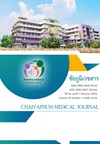ปริมาณเชื้อไวรัสในกระแสเลือดของผู้ติดเชื้อ HIV/ผู้ป่วยเอดส์ หลังได้รับยาต้านไวรัส และติดตามผลการรักษาครบ 4 ครั้ง ในรอบ 3 ปี
คำสำคัญ:
ปริมาณเชื้อเอชไอวีในกระแสเลือด, ผู้ติดเชื้อเอชไอวี/ผู้ป่วยเอดส์, การติดตามผลการรักษา, ยาต้านไวรัสบทคัดย่อ
โครงการรักษาเอชไอวีในผู้ป่วยของประเทศไทย ตั้งเป้าลดปริมาณการติดเชื้อในกระแสเลือด (HIV viral load) น้อยกว่า 200 copies/mL ในผู้ป่วยที่ได้รับยาต้านไวรัส ให้เหลือไม่เกิน ร้อยละ 95 ภายใน ปี 2573 การวิจัยนี้มีวัตถุประสงค์ เพื่อศึกษาปริมาณ HIV viral load ภายหลังได้รับยาต้านไวรัส ในการติดตาม 4 ครั้งในรอบ 3 ปี โดยเครื่องมือตรวจ Abbott Realtime m2000 system ที่ได้มาตรฐาน ในกลุ่มตัวอย่าง 230 ราย วิเคราะห์ผลด้วยสถิติพรรณนา และ Pearson’s correlation
กลุ่มตัวอย่าง 230 ราย เป็นผู้ติดเชื้อเอชไอวี/ผู้ป่วยเอดส์ ที่ได้รับยาต้านไวรัส และติดตามตรวจ viral load ครบทั้ง 4 ครั้งหลังได้รับยา ในรอบ 6 เดือน 1 ปี 2 ปี และ 3 ปี ตามลำดับ คิดเป็น ร้อยละ 82.7 ของจำนวนผู้ป่วยที่เฝ้าติดตามทั้งหมด ลักษณะทางประชากร เป็นชายมากกว่าหญิงเล็กน้อย (ร้อยละ 53.0: 47.0) และมีอายุเฉลี่ย 44.62 ปี ปริมาณ HIV viral load จากการติดตามครั้งที่ 4 (3 ปี) พบว่า อยู่ในระดับที่ตรวจไม่พบ (viral load < 40 copies/mL) ร้อยละ 96.1 ขณะที่ viral load = 40 ถึง 1,000 copies/mL พบ ร้อยละ 2.2 และ viral load > 1,000 copies/mL พบ ร้อยละ 1.7 ทั้งนี้ จากการติดตาม 4 ครั้ง พบ viral load หลังได้รับยาต้านไวรัส อยู่ในระดับที่ตรวจไม่พบเพิ่มขึ้นตามลำดับ (ร้อยละ 58.5, 86.1, 95.2 และ 96.1) นอกจากนี้ ยังพบว่า ค่าปริมาณ viral load และ log ที่ได้จากเครื่องมือ Abbott Realtime m2000 มีความสัมพันธ์เชิงบวก ร้อยละ 59.8 (Pearson’s corr. = 0.598) และจากการติดตามกลุ่มที่ยังมีปัญหา (viral load > 40 copies/mL) พบพฤติกรรมการกินยาไม่ต่อเนื่อง ไม่สม่ำเสมอ และขาดยา โดยมีสาเหตุมาจากปัญหาครอบครัวและการเดินทางมารับยา
ผู้ติดเชื้อเอชไอวี/ผู้ป่วยเอดส์ ที่ได้รับยาต้านไวรัส และติดตามผลครบกำหนด มีแนวโน้มที่ดีในการลดปริมาณการติดเชื้อในกระแสเลือด รวมถึงผลสัมฤทธิ์ในกลุ่มตัวอย่างดังกล่าว (ร้อยละ 82.7) ซึ่งใกล้เคียงกับค่าเป้าหมาย (ร้อยละ 95.0) อย่างไรก็ตาม ระยะเวลาที่เหลือ จะถูกนำไปใช้ในกิจกรรมรณรงค์กระตุ้น และการจัดการรายกรณีเพื่อผลสำเร็จตามเป้าหมายที่วางไว้
เอกสารอ้างอิง
World Health Organization. HIV and AIDS. 2023. [Internet]. [cited 2024 May 31]. Available from: https://www.who.int/news-room/fact-sheets/detail/hiv-aids?gad_source=1&gclid=CjwKCAjwmYCzBhA6EiwAxFwfgG_WDsOGx1VuCWP-qfJhCHbMu7SlpbY902imAK-P-pzQsyc9aNW3RRoCdWEQAvD_BwE.
UNAIDS. Epidemiological estimates FACT SHEET 2023 Global HIV statistics. [cited 2020 Apr 16]. Available from: https://www.unaids.org/sites/default/files/media_asset/UNAIDS_FactSheet_en.pdf.
Wang YP, Jing WZ, Du M, Kang LY, Shang WJ, Liu J, et al. Epidemic situation of HIV/AIDS and change trend in Belt and Road countries. Zhonghua Liu Xing Bing Xue Za Zhi 2022;43(7):1053-9.
Stephenson J. Asia’s growing HIV/AIDS epidemics in spotlight at international Conference. JAMA 2004;292(10):1161-2.
Brown T. HIV/AIDS in Asia. Analysis from the East-West Center. Asia Pacific Issues 2003;68:1-2.
กรมควบคุมโรค. สถานการณ์เอชไอวีประเทศไทย ปี 2565. [Internet]. 2566. [cited 2024 May 31]. Available from: https://ddc.moph.go.th/uploads/publish/1549120240328063459.pdf.
Granich R, Williams B, Gupta S, & Zuniga JM. 90-90-90, epidemics control, and ending AIDS: review of global situation and recommendations. bioRxiv (Cold Spring Harbor Laboratory) 2017;pp196972.
Winichakoon P, Tongjai S. The Emerging of CRF01_AE: A Clinical Story and Future HIV/AIDS Situation in Thailand.
Curr HIV Res 2020;18(2):74-84.
Mega ER. Alarming Surge in Drug-Resistant Hiv Uncovered. Nature 2019.
Ruxrungtham K, Chokephaibulkit K, Chetchotisakd P, Chariyalertsak S, Kiertburanakul S, Putacharoen O, et al. Thailand National Guidelines on HIV/AIDS Treatment and Prevention 2021/2022. Nonthaburi: Division of AIDS and STIs, Department of Disease Control, 2022.
กระทรวงสาธารณสุข. แนวทางการตรวจรักษาและป้องกันการติดเชื้อเอชไอวี ประเทศไทย ปี 2557. นนทบุรี : สำนักโรคเอดส์วัณโรคและโรคติดต่อทางเพศสัมพันธ์ กรมควบคุมโรค กระทรวงสาธารณสุข, 2557.
อรรณพ หิรัญดิษฐ์, [บรรณาธิการ]. Strategies to Improve Adherence to Antiretroviral Therapy. กรุงเทพฯ: บริษัทประชาชน, 2550.
วันทนา มณีศรีวงศ์กูล. การสังเคราะห์ความรู้เกี่ยวกับความต่อเนื่องสม่ำเสมอในการรับประทานยาต้านไวรัสเอดส์. ใน พีระมน นิงสานนท์, สัญชัย ชาสมบัติ, ธิดาพร จิรวัฒนะไพศาล และสุวนีย์ ใหม่สุวรรณ, [บรรณาธิการ]. สรุปบทเรียนการส่งเสริมการรับประทานยาต้านไวรัสอย่างต่อเนื่องสม่ำเสมอสำหรับผู้ติดเชื้อและผู้ป่วยเอดส์. กรุงเทพฯ: โรงพิมพ์ชุมชนสหกรณ์การเกษตรแห่งประเทศไทย, 2547.
ชยันตร์ธร ปทุมานนท์. ระบาดวิทยาการแพทย์. เชียงใหม่ : PHRCG Pub, 2541.
Kiyaga C, Fong Y, Okiira C, Kushemererwa GE, Kayonggo I, Tadeo I, et al. HIV viral load assays when used with whole blood perform well as a diagnostic assay for infants. PLoS One 2022;17(6):e0268127.
Ngongo NM, Ntambwe EK, Nani-Tuma HS, Mambimbi MM, Ndona MM, Mashi ML, et al. Human Immunodeficiency Virus Viral Load Monitoring and Rate of Virologic Suppression Among Patients Receiving Antiretroviral Therapy in Democratic Republic of the Congo, 2013 – 2020. Open Forum Infect Dis 2023;10(6):ofad242.
Stover S, Milloy MJ, Grant C, Fairbairn N, Socias ME. Estimating the minimum antiretroviral adherence required for plasma HIV-1 RNA viral load suppression among people living with HIV who use unregulated drugs. AIDS 2022;36(9):1233-43.
Valantin MA, Durnad L, Wirden M, Assoumou L, Caby F, Soulie C, et al. Antiretroviral drug reducing in highly experienced HIV-infected patients receiving a multidrug regimen: the ECOVIR study. J Antimicrop Chemother 2019;74(9):2716-22.
Hoenigl M, Chaillon A, Moore DJ, Morris SR, Mehta SR, Gianella S, et al. Rapid HIV Viral Load Suppression in those Initiating Antiretroviral Therapy at First Visit after HIV Diagnosis. Sci Rep 2016;6:32947.
ยุทธชัย ไชยสิทธิ์, รัตติยา ทองอ่อน, เพ็ญศิริ ดำรงภคภากร, บุญรอด ดอนประเพ็ง, ดวงใจ บุญคง และพัชนี สมกำลัง. กลยุทธ์การส่งเสริมความสม่ำเสมอในการรับประทานยาต้านไวรัสเอชไอวี: การทบทวนวรรณกรรม. วารสารมหาวิทยาลัยนราธิวาสราชนครินทร์ 2556;5(3):13-24.
เสาวนิจ นิจอนันต์ชัย และจิราพัชร พิลาจันทร์. ปัจจัยที่มีผลต่อการมีส่วนร่วมในการป้องกันปัญหาโรคเอดส์ของชุมชนเขตคลองสาน กรุงเทพมหานคร [สังคมสงเคราะห์ศาสตรมหาบัณฑิต]. กรุงเทพมหานคร: มหาวิทยาลัยหัวเฉียวเฉลิมพระเกียรติ, 2549.
Chaitha I. Experience in Using Antiretroviral Therapy in Cross-border Areas along the Mekong River. Journal of Health Systems Research 2007;1(2):199-211.
Ruxrungtham K, Chokephaibulkit K, Chetchotisakd P, Chariyalertsak S, Kiertburanakul S, Putacharoen O, et al. Thailand National Guidelines on HIV/AIDS Treatment and Prevention 2021/2022. Nonthaburi: Division of AIDS and STIs, Department of Disease Control, 2022.
ดาวน์โหลด
เผยแพร่แล้ว
ฉบับ
บท
การอนุญาต
ลิขสิทธิ์ (c) 2024 ชัยภูมิเวชสาร

This work is licensed under a Creative Commons Attribution-NonCommercial-NoDerivatives 4.0 International License.





